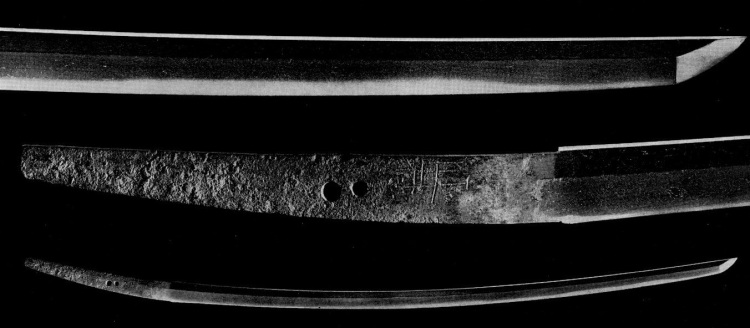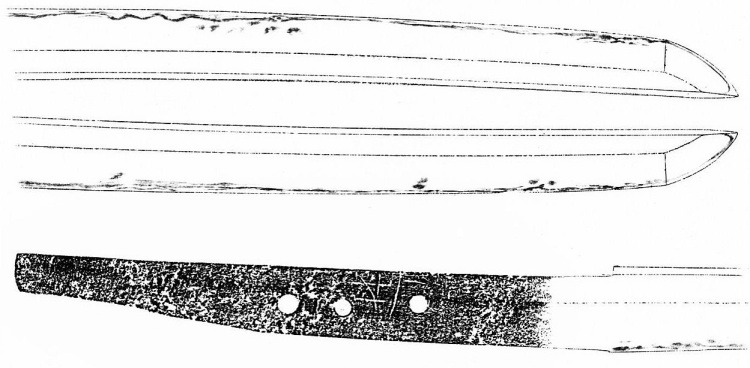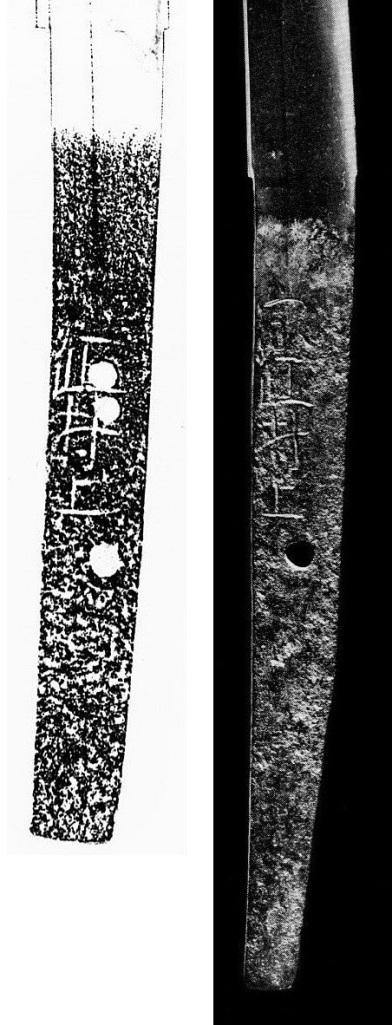With this chapter, I would like to close on the Sanjô School. Apart from Munechika and a few blades of (one) Yoshiie that are most likely Sanjô works, there are really not that many blades extant from this school. One Sanjô smith by whom at least a handful of works are known is Chikamura (近村) who is traditionally listed as son of Munechika. Well, some sources say he was the son of Yoshiie and the grandson of Munechika and in terms of workmanship, his blades come indeed pretty close to those of Gojô Kanenaga (兼永) who was the son of Munechika’s son Arikuni (有国) and Munechika’s grandson accordingly. In terms of sugata, Chikamura’s blades show an elegant and conspicuously curved tachi-sugata that is typical for early Yamashiro works but they are not that slender as those of Munechika. So we have here again a certain gap that speaks more for the grandson than for the son approach. The probably most famous blade of Chikamura is the one that was once preserved in the Tanzan-jinja (談山神社, Nara) and that went into the possession of the Imperial family before it was transferred into the Tôkyô National Museum where it is preserved today (picture 1). It shows a somewhat standing-out itame with ji-nie and a ko-midare in ko-nie-deki that is mixed with many ko-ashi and yô, kinsuji, and nijûba along the monouchi. The nioiguchi is rather subdued and hajimi appear in places but it has to be mentioned that the blade is a little tired. The bôshi is sugu with a ko-maru-kaeri and shows some nijûba too. The tang is ubu, tapers to a shallow kurijiri, shows kiri-yasurime, and bears over the mekugi-ana a large and finely chiselled niji-mei that is positioned more towards the nakago-mune.
Picture 1: tachi, mei “Chikamura” (近村), nagasa 78.1 cm, sori 2.7 cm, shinogi-zukuri, iori-mune
In picture 2, that shows another signed Chikamura tachi, you can seen some remnants of the “multi-layered” aproach of Munechika but not that “extreme” as it is the case at the Sanjô founder. On the other hand, Chikamura’s blades have in general a more ancient feel than those of Yoshiie and if I had to decide whether Chikamura or Yoshiie was the son of Munechika, I would go for Chikamura for the time being. The blade seen in picture 2 shows an itame with plenty of ji-nie and chikei. The hamon is nie-laden ko-midare that is mixed with kinsuji, yubashiri and plenty of sunagashi. The bôshi is a narrow sugu with a ko-maru-kaeri. The tang is a little machi-okuri, has a shallow kurijiri, katte-sagari yasurime, and bears just like the former gyobutsu a large and fine, ancient looking niji-mei that was chiselled above the initial mekugi-ana and towards the nakago-mune.
Picture 2: tachi, mei “Chikamura” (近村), nagasa 68.8 cm, sori 2.4 cm, shinogi-zukuri, iori-mune
When we are talking about Chikamura, the famous mei has to be mentioned that gave birth to some controversial theories in the Meiji era. The original signature was “Chikamura tatematsuru” (近村上), “offered/presented by Chikamura” (i.e. either to a high-ranking client or to a religious facility), but someone later added the character for “Mune” atop of it to allude to Munechika and to create the mei (宗近村上). This mei was then interpreted by some as “Munechika Murakami,” i.e. the character “mura” (村) from Chikamura and the character “tatematsuru” (上) which also reads “kami” were interpreted as the family name Murakami and the theory was forwarded that this must had been Munechika’s family name. But comparative studies have shown that, as mentioned, the character for “Mune” was a later add-on as another blade of Chikamura was discovered that was signed “Chikamura tatematsuru” (see picture 3). Incidentally, this kind of mei is not that uncommon. For example, there are also offering/presentation blades with the prefix or suffix tatematsuru extant by Rai Kunimitsu and Fukuoka-Ichimonji Sukeyoshi (助吉).
Picture 3: The enlarged Chikamura mei right and the other “Chikamura tatematsuru” mei left.
Well, when it comes to Chikamura and to several of the other Sanjô smiths – first of all Yoshiie as mentioned in the last chapter – we are facing one interesting similaritiy, namely that were homonymous early Bizen smiths active for many of them. For example, there was a Ko-Bizen Chikamura who worked, depending on source, around Genkyû (元久, 1204-1206) or Bunryaku (文暦, 1234-1235). The same goes for Munetoshi (宗利), Muneyasu (宗安), Munenori (宗則), Sanenori (真則), and Sanetoshi (真利). And then there were the two smiths who had a certain relation to Kawachi province, Arikuni (有国) and Arinari (有成), who are listed as students or sons of Munechika. So some say that Arinari came originally from the northern Ôshû Môgusa group and that he went to Kyôto to study with Munechika before he eventually settled in Kawachi. And Arikuni was either a student who moved later to Kawachi where he studied with Arinari or that there were two Arikuni, a Sanjô smith who never left Kyôto and a Kawachi smith who belonged to the school of Arinari and who was not directly connected to Munechika. Another interesting coincidence is that several of the early northern Ôshû smihs are listed as having moved down to Bizen where they acted as co-founders of the Ko-Bizen group. For example, Arinari’s initial master Arimasa (有正) was, according to tradition, also the master (or even father) of the famous Ko-Bizen Masatsune (正恒). This suggests that either (a) these northern Môgusa smiths were much more predominant than we think of them today and spread to all provinces where they greatly contributed to the establishment of the most renowned schools (e.g. Sanjô, Ko-Bizen), or (b) that at least some of the early Yamashiro smiths moved later to Bizen province, (c) that all these identical smith names are just a big coincidence, or (d) that some of these homonymous smiths were later “invented” by chroniclers to establish certain connections or fill genealogic gaps.
Picture 4: tachi, mumei, Ishikirimaru, attributed to Kawachi/Sanjô Arinari, nagasa 76.1 cm, sori 2.5 cm, preserved in the Ishikiritsurugiya-jinja (石切剣箭神社, Ôsaka)
Anyway, as far as all the other recorded Sanjô smiths are concerned, there are as mentiond in the beginning next to zero works of them extant. One of the several swords nicknamed Ishikirimaru (石切丸) is attributed to Arinari (see picture 4). So there is not much to add from a kantei point of view, except for the fact that it is anyway extremely unlikely to come across one of these earliest Yamashiro blades in the wild (and outside of Japan). For an overview of the Sanjô School and also in view to the upcoming chapter that deals with the Gojô School, I add their common genealogy below.



